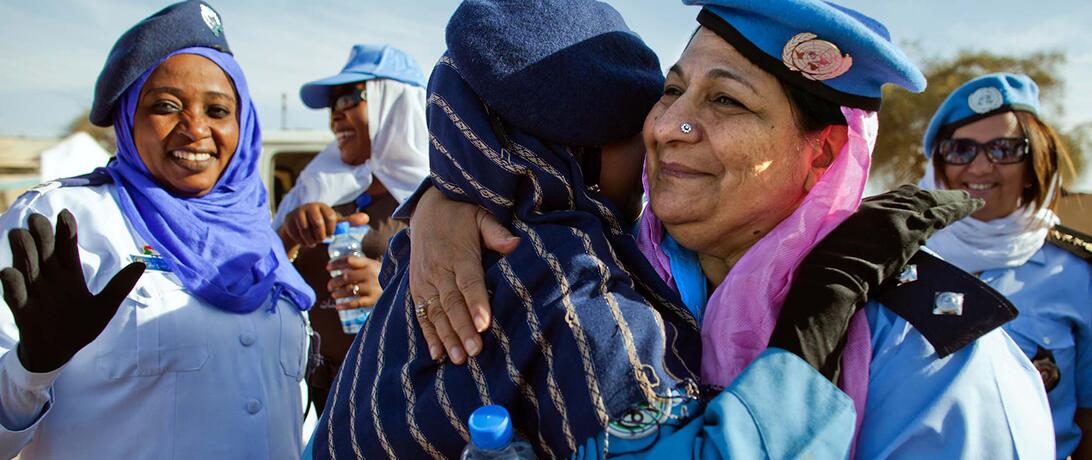
Reflecting on International Day for the Elimination of Violence against Women, OSF highlights gender perspective in the arenas of peace and security operations, governance, and conflict resolution.
Each year, November 25 marks the International Day for the Elimination of Violence against Women. Two of the best practices for mitigating violence against women are using a gender perspective and promoting higher levels of women’s participation in peace and security operations, governance, and conflict resolution. The use of a gender perspective in these arenas shows that, when women are considered and included, peacekeeping, governance, and conflict resolution are all more effective and lead to better outcomes for women.
Peace and Security Operations
Women’s participation in police and peacekeeping operations has been shown to reduce violence against women in a variety of ways. One reason is that an increase in women among security personnel correlates with increased reporting of sexual and gender-based violence. This is due to a perception that female officers are more approachable than male officers. In a study conducted in the United States, it was found that not only are female police officers more approachable and more likely to use communication over excessive force, but they also respond more effectively to cases of domestic violence. The same can be said of women police serving among peacekeeping forces, and for that reason it has been recommended that local women serve as police officers in post-conflict areas with high rates of domestic violence.
Multiple case studies indicate that increasing the number of women security personnel and using a gender perspective help to increase the situational awareness and overall success of peace and security operations. In Iraq, lack of a context-specific gender perspective had negative consequences for Coalition Forces when they detained and interrogated a woman from a Shiite-dominated village without any male family members present because they were unaware of the cultural implications of doing so. The villagers suspected she may have been raped or abused by Coalition Forces, and she was subsequently stoned to death. However, in other NATO operations conducted in the region, incorporating a gender perspective led to better situational awareness and, therefore, better information on sexualized violence.
Furthermore, when women make up a critical mass of 30 percent or higher among peacekeeping forces, their presence helps to reduce instances of sexual assault and harassment by male peacekeepers in conflict-affected populations.
Political Leadership
Women’s participation in government is not only good for women but also good for men. Political gender equality—measured by women chief executives and the proportion of women in parliament—directly correlates with diminished levels of human rights abuses perpetrated by states.
Female leaders in government are key to creating more gender-sensitive legal frameworks. A survey of legislation efforts in Africa found that countries with higher representation of women in government were more likely to pass protection-oriented legislation. Examples include Rwanda’s Gender-Based Violence Bill, the Anti–Female Genital Mutilation Bill in Uganda, Tanzania’s maternity leave bill, and more progressive laws on domestic violence and reproductive rights in South Africa. In the United States, it was found that states with more elected women in office were more likely to pass “women-friendly” policies.
Conflict Resolution
Likewise, increasing women's participation in peace processes contributes to more lasting and durable peace. Women are known for their ability to build trust and bridge divides. When they are engaged in peace processes, it makes them 64 percent less likely to fail and 35 percent more likely to last at least 15 years.There have been no instances in which women’s participation has had a negative impact on peace. This means that women’s participation in peace processes contributes not only to the elimination of violence against women in conflict situations but also to the elimination of violence against women, men, boys, and girls alike.
It is not enough only to make sure that a certain number of women are included in these peace processes. In addition, it is imperative that a gender perspective be used throughout the duration of the negotiations. When this does not occur, it is assumed that the needs of women and girls are being met when they are actually being overlooked. Rather than using “gender-neutral” language that fails to outline the specific needs of women and girls, peace agreements need to use “gender-positive” language to ensure they are meeting the needs women.
Our Secure Future Fellow Ambassador Don Steinberg can attest to this from his personal experience as Ambassador to Angola during the country’s peace process. Ambassador Steinberg found that the use of seemingly gender-neutral language led to the needs of women being left out of agreements. A devastating consequence of this was that the fields and paths women and children used to haul water and collect firewood were not considered in the country’s demining process, which only cleared major roads, making it dangerous to complete tasks such as farming or collecting water and firewood. When a gender perspective is used, peace agreements include more specifically gendered language and more provisions that specifically apply to women.
A Way Forward
Women are not only vulnerable to violence but uniquely positioned to help end it as peacekeepers, political leaders, and peacebuilders. If the international community hopes to eliminate violence against women, a universal commitment to use a gender perspective and increase women’s leadership must be a part of that approach.
*Data for this blog are based on Our Secure Future’s upcoming publication, Just the Facts: A Selected Annotated Bibliography to Support Evidence-Based Policymaking on Women, Peace and Security.
Article Details
Published
Topic
Program
Content Type
Opinion & Insights